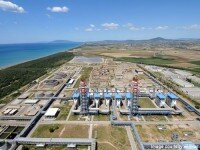Italy must lead energy efficiency and renewable production worldwide
Posted in Policy, Technology on 03/12/2010 11:26 am byAs a result of its energy efficiency indicators and the expansion of its renewable programme, Italy has the capacity to lead worldwide production of renewable energy and set standards for an efficient model. Indeed, Italy is the most energy efficient country of the G8, with a 57% energy used per unit of GPD, in comparison to the USA. Traditionally high energy prices (the second highest electricity prices in Europe, after Denmark) have resulted in more efficient consumer behaviours (see UN: Energy uses per unit of GDP).
Gas prices are also generally higher than in rest of the EU – 4% above European averages in 2006 for the average household gas price (average gas price for industrial users was still about 14% lower than the European averages; see Europa: Italy – Internal Market Fact Sheet).
Italy does not have considerable reserves of fossil fuels. The country relies on foreign sources to meet 90% of its energy needs and it is one of the largest importers of oil. Therefore, diversification is considered priority. However, according to 2006 data, only 5.5% of the total energy in Italy came for renewable sources. (The amount of electricity generated from renewable sources rose by one fifth in Italy in 2008 while overall demand fell by 0.1%, according to official statistics by transmission system operator, Terna.)
Over the past decade, the country has developed a strong growth of onshore wind, biogas and biodiesel. The expansion of wind energy has developed impressively in the last few years. Italy is now the world’s sixth largest producer of wind power with a capacity of 3,736Mw in 2008 (source: European Wind Energy Association (EWEA)).
Italy is also leader in production of geothermal energy. Indeed, geothermal-generated electricity was first produced at Larderello in 1904. The current production is of 5 billion kilowatt hours of power a year, which, according to the Economic Development Ministry, can provide power for 6 million people. Last February, the ministry announced the simplification of procedures for the development of geothermal energy projects (see Reuters: Italy simplifies geothermal energy permitting).
Solar generated power still needs a definitive impulse in Italy. The country is Europe’s third-biggest solar power producer after Germany and Spain, but it gets less than one percent of its power from PV installations at present, despite its government’s incentives and ample sunshine, and probably due lately to the difficulties in accessing bank financing for both operators and clients.
However, the production of dirty energy is still large. Italy accounts for a 2% of the total national greenhouse gas emissions as a percentage of global total (2004 data) and the per capita annual greenhouse gas emissions rose from 9.2 tones in 2000 to 9.7 in 2005.
In 2007, Enel signed a memorandum of understanding with Albania under which it plans to build a thermal generation plant fuelled by imported coal. The plant will serve the markets in both countries (see Enel 2007 Annual Report, page 87 ). However, as Albania is not an EU member, the plant is not likely to abide by existing EU rules on air pollution, such as the Large Combustion Plants Directive, nor by future rules under the EU’s Industrial Emissions Directive currently being negotiated (see Europa: IPPC Directive). It would also be a way around the cost of carbon emissions under the EU’s Emissions Trading Scheme.
The major drawbacks for Italy to achieve the renewable energy targets set at national and EU level are mainly the complex administration procedures for industrial projects, especially at regional and local levels, and high financial barriers, such as the elevated cost on grid connections. Renewable producers’ association, Aper, claims that Italy will not meet its 25% renewable target by 2020 without better government support.
 Francesca Polini runs the communications company We Care and can be contacted at: francesca@wecare.eu.com.
Francesca Polini runs the communications company We Care and can be contacted at: francesca@wecare.eu.com.



05/11/2010 at 6:31 pm
Gas prices these days are just getting higher, I think the government should focus more on alternative energy.
07/30/2011 at 4:50 am
I am really impressed by your article this one tells a totally different story about the renewable energy resources. I agreed with you that govt. should try to find out new sources for energy otherwise in the mean time leading to destruction won’t be far.